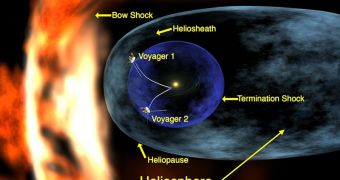A not so unusual but rather unexpected discovery has been made recently regarding the shock wave generated by the solar wind, as it meets the emissions given off by close-by stars. It seems that the general area of the termination shock through which Voyager 1 and Voyager 2 passed on their way out of the solar system presents a dent or an irregularity.
The Voyager 1 and 2 missions, launched in the late 1970s in order to take advantage of the planet's alignment, had as primary mission the study of the two largest gas giants in the solar system, Jupiter and Saturn; however in their path they were actually destined to leave the solar system to study its most outer regions.
The first probe ever to pass the terminal shock boundary, located between the heliosphere and the interstellar space, was Voyager 1 in December 2004 when it first discovered the irregularity in the shock wave. The terminal shock boundary represents the limit where the solar wind decelerates to subsonic speeds as it meets the wind of electrically charged particles generated by the surrounding stars present in the Milky Way, traveling at speeds as high as 3.2 million kilometers per second, forming a relative sphere that has the boundary far beyond the orbit of the dwarf planet Pluto.
The twin spacecraft of Voyager 1, Voyager 2, launched shortly after its sister, followed a trajectory slightly wider on its path towards the outer limits of the solar system, thus it started crossing the termination shock in late August, meaning it is now at a distance of more than 16 billion kilometers from Voyager 1. Measurements made by the spacecraft revealed that indeed the shock wave is squashed and pushed inward towards the solar system by more than 1.6 billion kilometers in the region where Voyager 2 made the crossing.
However, unlike Voyager 1, which made only one cross of the shock wave, Voyager 2 made a series of multiple crossings as the terminal shock oscillates back and forth, according to the position of the Sun, allowing detailed measurements of speed, density and temperature. Data related by the spacecraft reveal that the actual shock wave has a lower temperature than previously predicted, which suggests transfer of energy to cosmic rays, accelerated at extremely high speeds in shock wave.
The origins of these cosmic rays are still uncertain, but what is for sure is that they do not originate in the area where either of the Voyager spacecrafts crossed the termination shock. Both are now in the heliosheath and moving away from the Sun. They will continue their missions until 2020 when they will suffer a critical power failure, meaning that they won't be able to power not even a single instrument present on board, and will continue to travel through the interstellar space of the Milky Way.
NASA's Interstellar Boundary Explorer upcoming mission will probably reveal more information regarding the variations observed in the terminal shock wave.

 14 DAY TRIAL //
14 DAY TRIAL //